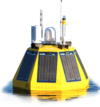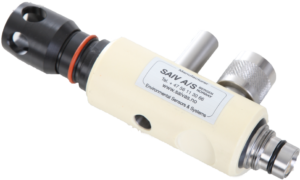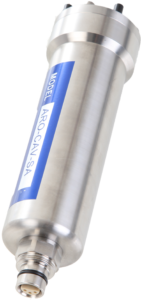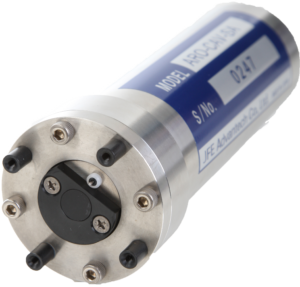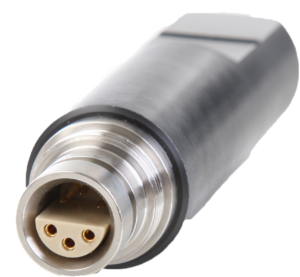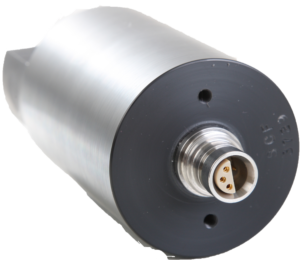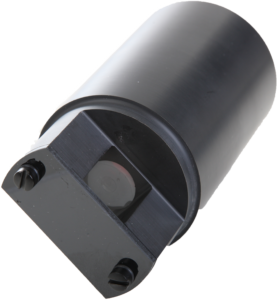SAIV205 Oxygen sensor:
The SAIV Oxygen is a probe that is built on Oxyguard dissolved oxygen probe. The sensor i s a membrane-covered galvanic cell that generates its own voltage(clark-cell). The SAIV oxygen probe is designed to fit the SAIV SD204 and SD208 CTD instruments without any extra cables or units. The SAIV oxygen sensor is easy to add to the SD models. It can operate in lakes and oceans at depths up to 6000 m.
The oxygen sensor is an electro chemic sensor and need daily calibration in air. The SD204 and SD208 has a build in calibration option, that can do the calibration with a few commands. The SAIV205 oxygen work very well with the APB5 (Automatic CTD profiler) since it will be automatic calibrated every day by the APB5 system.
It is possible to use the SAIV205 together with OSU106 that can have 2 more sensors additionally to the SAIV205.
OSU106 Optional Sensor Unit
The SAIV OSU106 (Optional Sensor Unit) is a attachment unit to SD204 and SD208. The OSU106 will together with the SD model become a multi parameter probe/ Instrument. The OSU106 have physical mounting brackets for sensors like turbidity, fluorescence, PAR, optical oxygen sensors and more. It also contains a packet of lithium batteries for powering the sensors.
The limitation of the OSU106, is that is can only fit two (2) sensor at the time (due to physical limitations ).
Note: SAIV205 oxygen sensor will be able to use on the SD instrument together with the OSU106.
Single or split SAIV cable is needed for connectivity to the sensors.
Rinko III Oxygen sensor with SAIV connector.
The Rinko Oxygen sensor is a fast optical DO (dissolved oxygen) sensor from JFE. The sensor is fitted with SAIV plug/bulkhead.
The DO sensor has high-accuracy and high resolution based on the phosphorescence principle. Compared to commercial galvanic, clark-cell and optical DO sensors that can have a response time from 15 sec to 1 minute. Rinko has a response time of less than 1s in air (90 % response typical) . This means that together with the fast CTD profiler SD208 it can do a vertical oxygen profile in a speed of 0.5 m/s.
OSU106 and cable is needed for interfacing with SAIV CTD profilers.
An optical oxygen sensor will not need a daily calibration in air and is more suited for long term measurements.
If calibration is needed (i.e it do not read 100 % in air) a util Rink oxygen calibration option is available in the mini-software SD200W
Read more about this sensor at JFE
Turbidity sensor with SAIV connector.
The turbidity sensor/meter is a Seapoint sensor with SAIV plug/bulkhead connector. The sensor detects light scattered by particles suspended in water. This generating an output voltage proportional to turbidity or suspended solids. The turbidity sensor can be used with ctd profiler SD204 and SD208, OSU106 and cable is needed for interfacing with the SD models.
The turbidity can operate in 4 ranges. The SAIV CTD profiler have "Auto Range" functionality. This will make the turbidity max sensitive based on the particles in the water. The sensor can operate down to 6000 meters and have (less than) < 2% deviation 0-1250 FTU
Read more about this sensor at Sea Point
Fluorescence sensor with SAIV connector.
The fluorescence sensor or also called Fluorometers is a Seapoint sensor with SAIV plug/bulkhead connector. It can measure compounds such as Chloropyhll, CDOM, Crude Oil, and Fluorescein, Rhodamine, and UV Tracer Dyes.
The Chlorophyll fluorometer (SCF) is most frequently requested. The SCF used modulated blue LED lamps and a blue excitation filter to excite chlorophyll. All version of the Seapoint fluorometers can be used with SAIV CTD profilers SD204 and SD208, OSU106 and cable is needed for interfacing.
The fluorometers can operate in 4 ranges. The SAIV CTD profiler have "Auto Range" functionality. This will make the fluorescence max sensitive based on the compounds in the water. The sensor can operate down to 6000 meters
Read more about this sensor at Sea Point
